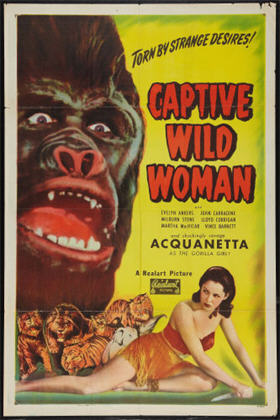
“Suppose your experiment is successful? What will you have? A human form with animal instincts…”
Director: Edward Dmytryk
Starring: John Carradine, Evelyn Ankers, Milburn Stone, Acquanetta, Lloyd Corrigan, Fay Helm, Martha MacVicar (Martha Vickers), Paul Fix, Ray Corrigan
Screenplay: Griffin Jay and Henry Sucher, based upon a story by Ted Fithian and Neil P. Varnick
Synopsis: Fred Mason (Milburn Stone) returns from a two-year expedition capturing animals for the Whipple Circus. His reunion with his fiancée, Beth Colman (Evelyn Ankers), is interrupted when a tiger gets loose; Stone must exert all his skills to recapture the animal. On their way to the circus’s office, Beth tells Stone about her younger sister, Dorothy (Martha Vickers), who has developed a glandular illness. She explains that Dorothy is now at the Crestview Sanatorium under the care of Dr Sigmund Walters (John Carradine), who is the leading expert in this field. Slyly, Beth tells Stone that she has had dinner once or twice with Walters, as well as inviting him to inspect the circus; but Mason is more amused than jealous. John Whipple (Lloyd Corrigan) greets Stone enthusiastically. As the two men and Beth set out to inspect the new animals, Dr Walters arrives, and Whipple invites him to join them. In addition to the many lions and tigers, Mason has brought back a female gorilla he calls Cheela (Ray Corrigan), speaking enthusiastically of her intelligence and his plans for building a circus act around her. One of the hands, Gruen (Paul Fix), drunkenly mistreats Cheela, and is attacked. Mason rescues him, and Whipple dismisses him from the circus. Dr Walters, watching thoughtfully, asks whether the circus ever sells animals like Cheela, and learns that if they work out for the circus, no money could purchase them. Back at his laboratory, Walters learns that the subject of his latest experiment has died. He speaks frustratedly of the need for a larger, stronger experimental subject—particularly now, when Dorothy Colman’s glandular condition makes her an ideal donor. Walters’ nurse, Miss Strand (Fay Helm), reacts with shock to the thought of experimenting on a human being. Walters only sneers, telling her that work such as theirs requires daring… Later, Walters tracks down the disgruntled Gruen and, over several drinks, hires him to steal Cheela. Gruen succeeds in doing so but, when he asks for money, Walters manoeuvres him into Cheela’s reach… Gruen’s death and Cheela’s disappearance are headline news, and Whipple worries that the incident will have serious repercussions for his circus. Beth learns from Dr Walters that Dorothy will need an operation; she confesses to Mason that she is very worried about her sister’s health. In fact, Walters’ experiment involves transfusing Dorothy’s blood into Cheela, before performing surgery on the ape. As Miss Strand looks on in horrified disbelief, she sees Cheela’s exposed hand transform into that of a young woman… Walters is thrilled by the success of his experiment, but Miss Strand announces wildly that she cannot help with his work anymore; that she will not assist in experimentation on humans. As the doctor listens with contempt, Miss Strand tries to make him see how far his thinking and his principles have become warped since they first began to work together. Walters points out that his gland transplantation experiments have always worked, but Miss Strand counters that in each experiment, the donor animal died… When Walters remains unmoved, Miss Strand threatens to call the police—prompting Walters to observe that he has another experiment in mind, and needs another donor…
Comments: Captive Wild Woman can perhaps best be compared to Murders In The Zoo, and not only because of these films’ captive animals backdrop. When I reviewed the latter film I called it, “Half of an excellent horror movie”—half, because its astonishing psycho-sexual main plot is balanced, undermined really, by a mixture of misplaced comedy relief and distasteful footage involving the mistreatment of animals. Captive Wild Woman, though the word “excellent” should not venture anywhere near it, follows much the same format, only more so: its central mad-science plot occupies less than 40% of its total running-time of only seconds over an hour.
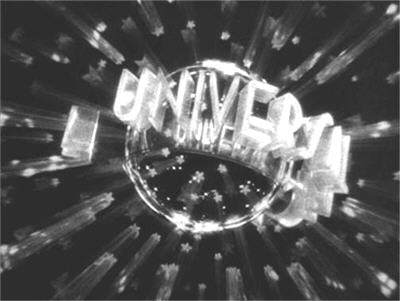
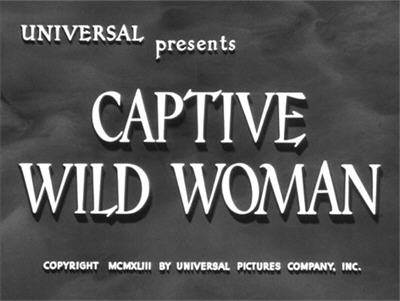
Disappointing as this is, the problem is vastly exacerbated by the nature of the footage that makes up the remainder of the film, most of which is lifted from another Universal production, 1933’s The Big Cage. The star of this earlier film was Clyde Beatty, who parlayed his fame as a headlining circus performer into a film career that lasted from the 1930s through to the 1960s. Beatty was an animal “trainer”—meaning that his act consisted of animals being caged, restrained, threatened, terrorised and humiliated for the amusement of the public.
…
Don’t get me started.
…
Earlier productions starring Beatty, in particular The Big Cage and the serial, The Lost Jungle (the latter regularly punctuated by sequences in which two random animals are tossed together are encouraged to fight), became a source of stock footage for any number of later films, including Captive Wild Woman; and while it is of course infinitely preferable that the footage should be reused, rather than the animal sequences being restaged, that doesn’t make the original material any less inherently vile.
(Okay, I guess I got started after all. Sorry about that.)

But as is the case with Murders In The Zoo, what is good about Captive Wild Woman is so very good, it makes the rest worth sitting through (or at least, fast-forwarding through). Offsetting the circus sequences is—John Carradine—in not just his first ever starring role, but his first outing as a mad scientist, too.
Carradine’s performance here gives the viewer an immediate insight into the subsequent direction of his career: such is the manic glee with which he throws himself into the role of “Dr Sigmund Walters” that we can readily believe the rumours that he never afterwards refused any role. This is a man who thoroughly enjoyed his work. Meanwhile, the script of Captive Wild Woman, by Griffin Jay and Henry Sucher, is in every way worthy of Carradine’s performance, offering up science that is not merely mad but bat-shit insane.
However, we are not immediately introduced to Dr Walters. Captive Wild Woman declares its intentions from its opening frames, starting with footage lifted from The Big Cage showing caged lions and tigers being unloaded from a cargo ship onto the docks. This activity forms a backdrop for the reunion of Fred Mason and his fiancée, Beth Colman, who have been separated for two years while Mason led an expedition to capture animals for the Whipple Circus, which employs them both.
Mason takes Beth to one side of the docks to introduce her to Cheela, a female gorilla, “The most gorgeous lady that ever came out of the jungles” (but played, of course, by Ray “Crash” Corrigan). We note immediately the rather counterintuitive inclusion of an opening in the gorilla’s cage through which she can extend her arm. Evidently it has never crossed Mason’s mind that Cheela might use this opening for any other purpose than enthusiastically shaking hands with him, a trick he shows off to everyone who subsequently comes near her.
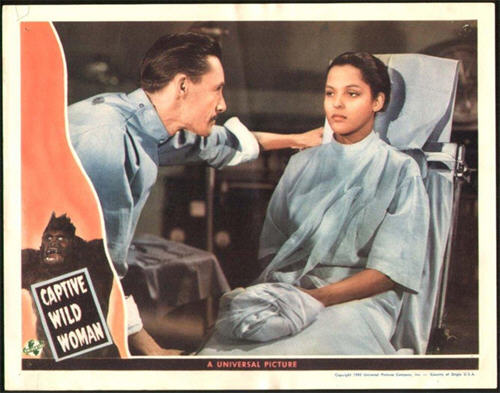
Suddenly, the lovebirds – Mason and Beth, that is, not Mason and Cheela; although… – are interrupted by a crash and a panic: a cage has worked loose from its ropes and fallen to the dock, smashing open and releasing a tiger (and causing me to shriek and cover my face for the first of many, many times during this film).
It is quickly evident that that Milburn Stone was cast in Captive Wild Woman because of his general physical resemblance to Clyde Beatty: a somewhat unlikely romantic lead, Stone’s main job here is to play the front of the back of Beatty’s head. Stone’s Fred Mason springs into, uh, action here, grabbing a chair and some passer-by’s cane and driving the tiger into an empty office…all without ever getting into the same shot as the animal. In fact, the vast majority of Milburn Stone’s “performance” in this film consists of him waving chairs, canes and whips around, as infinite stock footage unspools around him.
Once the tiger is safely contained, Mason calls for an empty cage, so that he can recapture it. We are disappointed, though not altogether surprised, when this feat is accomplished offscreen; nor will this be the last time Captive Wild Woman pulls that stunt.
In their taxi on the way to the circus’s head-office, Beth tells Mason about her sister Dorothy’s illness, diagnosed as a “glandular disorder”. That it is “glandular” is enough to cause several different doctors to recommend Dr Sigmund Walters of the Crestview Sanatorium.
(The supposedly chronically ill Dorothy is played by a radiant and disgustingly healthy-looking young Martha Vickers, still billed as “MacVicar”.)
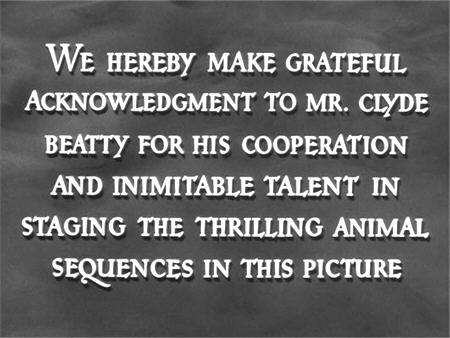
“Inimitable”—thank God!
We get a flashback here to the two nervous young women sitting in Walters’ waiting-room, where Beth finds a medical journal with an article highlighting Walters’ accomplishments in the field of endocrinology…which are rather unfortunately described as racial improvements. Thankfully, we learn that this means Dr Walters is able to cure various physical deformities through his understanding of glandular secretions and his discovery of “Vitamin E-2”, which in his opinion, “Determines the physical characteristics of all forms of life.”
(We also learn that human beings have 48 chromosomes [!], though this doesn’t seem to be Dr Walters’ own assertion.)
The sisters are called into the office, and we are at last in the company of Dr Walters himself; deliciously enough, he comes accompanied by an ambient thunderstorm. After listening to Dorothy’s symptoms, Dr Walters observes that, “Most ailments are traceable to glandular disorders.” Not that he’s the kind of doctor who sees his own specialty everywhere, or anything. Dorothy is then taken away to be examined and, as we later discover, admitted. Beth and Walters have a conversion in which she praises his various accomplishments, while he insists that he has barely scratched the surface of what’s possible.
“One feels that a single life-time is hardly sufficient,” he comments…while stubbing out his cigarette…
Cut back to the present, where Beth is wrapping up her story—observing in all seriousness that she and Dorothy were lucky to acquire Walters’ services, “Because he really is a very famous scientist.” She also tells Mason that she’s been out to dinner with Walters “a few times”, and how charming she finds him (you and me both, sister!), presumably to punish Mason for presenting Cheela to her in the light of a rival; but Mason remains sensibly unbothered.

Yes, yes, I know – he’s a murderer and a psychopath; but dayum…
Captive Wild Woman’s meta-sub-plot kicks in here, as we learn that the Whipple Circus is trying to sign Clyde Beatty, who is name-dropped throughout only to finally take on the role of Sir Not-Appearing-In-This-Film. Mason has brought back an obscene number of animals in expectation of Beatty’s involvement, but when no deal is struck with the famous animal trainer he persuades Whipple to allow him to take over the role.
In another weird meta-bit, we hear about one particularly dangerous lion called Nero that Mason hopes to make a centrepiece of his act: in reality, “Nero” was the name of a lion that once mauled Clyde Beatty – chalk one up for the good guys – although Beatty got his revenge after his recovery by facing the lion down in The Big Cage (footage of which duly turns up here).
Dr Walters shows up just as Whipple and Mason are setting out to inspect the animals, and is invited to join them. Their viewing of the big cats is interrupted by cries from nearby: Cheela has grabbed one of the handlers, Gruen, who has been drinking, and who made the dangerous mistake of striking her. However, Cheela releases Gruen on Mason’s command and shows her ordinarily gentle and friendly nature to the others. Whipple angrily dismisses Gruen, who departs casting anything but loving glances at the ape and his erstwhile employer.
As he watches Cheela’s interaction with Mason, Dr Walters’ eyes light up, and he makes some casual inquiries about whether the circus ever sells its animals…
Back at Crestview, Walters passes through a sliding panel set in the far wall of his office – which is decorated with a caduceus – into the laboratory in which he keeps his experimental animals – and his Conical Flasks filled with Mysterious Coloured Fluids – and from there into his personal operating-theatre. His nurse-assistant Miss Strand is there, with some bad news for him: his latest experimental subject has died.
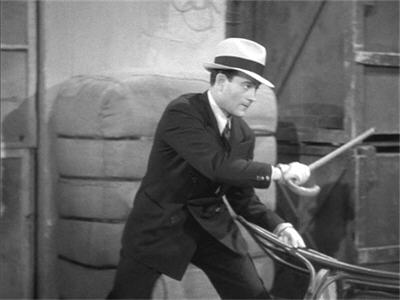

He’s the World’s Greatest Animal Trainer!…as long as there aren’t any animals around…
Like the later film, The Creeper, Captive Wild Woman gives the impression that it came about because someone read a scientific article that they found interesting but didn’t really understand. Rather shockingly, since we don’t expect a 40s B-movie to start messing about with the lady parts, Dorothy Colman is diagnosed as having a follicular cyst—that is, an ovarian follicle that does not rupture during ovulation, instead forming a fluid-filled cyst.
Far from being “a rare case”, as Walters contends, it’s very common and in most instances harmless; but occasionally there may be serious complications. Possibly the latter is what Dorothy is suffering from, but if so her symptoms are completely incompatible with that diagnosis: you would expect pelvic pain, nausea and bleeding, not the occasional dizzy spell and a flattering degree of weight loss.
The screenplay then makes us gasp again by asserting that Dorothy’s cyst has induced in her “the secretion of unusual amounts of the sex hormones”. Again, someone has evidently done some reading here, but not enough. The suggestion seems to be that Dorothy’s cyst is over-producing both oestrogen and progesterone (though naturally the screenplay uses neither word, nor of course does it ever say “ovary”), and is doing so simultaneously. Hilariously enough, rather than causing the riot of physiological misery we might expect, this situation is interpreted as making Dorothy “extra-female”…or so we infer from Walters’ subsequent conduct.
Miss Strand gets edgier and edgier through Walters’ discourse, as it becomes clear to her that he intends using Dorothy as a source of “glandular secretions”; and when he starts musing about the effects of transfusing those secretions into “a higher form of animal”, she bursts out that he cannot—that “the authorities” would never allow it.
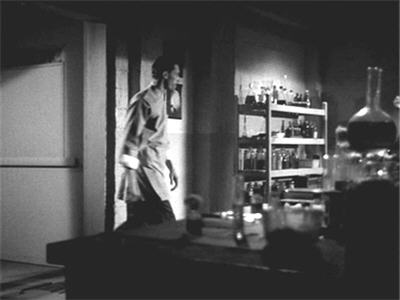

SCIENCE!!
Walters’ reaction to this remark is to turn on the unfortunate Miss Strand and deliver a smackdown not surpassed in the annals of science fiction until Whit Bissell’s appearance on the scene in 1957:
Dr Walters: “I see you’re not truly a scientist at heart, Miss Strand!”
All things considered, we are not altogether surprised when we next find Walters in the company of the disgruntled Gruen, pouring drinks into him while suggesting that he could both make money and revenge himself upon John Whipple by stealing Cheela. Gruen is amenable to the idea, and the next thing we know we find him lurking in a dark alley next to a truck with the caged Cheela loaded in the back; how exactly he accomplished this feat is left entirely to our imaginations.
(Not least because this doesn’t appear to be the same cage…but if it isn’t, it’s even more dangerous than its predecessor: now Cheela can reach out from between the bars!)
Walters meets Gruen as arranged, but reneges upon his promised payment in dramatic fashion, casually shoving Gruen to within grabbing distance of Cheela…
(And again I am put in mind of Murders In The Zoo…not just because of the animal-based homicide, but because of the Lionel Atwill-esque glitter in John Carradine’s eyes…sigh…)

“You DARE call me MAD!?…although come to think of it, you might have a point…”
And then it’s time for a mocked-up newspaper – yay! – although frankly, this one’s pretty disturbing. It has been a night of mayhem and murder in wherever the Daily Star is published, but none of the other many deaths – by fire, by car crash, by being hit by a car – can compete with what the paper insists upon calling the murder of Gruen…which apparently so overexcited the sub-editor, the cause of death is listed as both “strangulation” and – as a subheading helpfully spells out for us:
Nails of Beast Press Through Back of Neck Severing Spinal Cord.
Since Cheela has disappeared, it is concluded that she has escaped and is on the run. Not surprisingly, officialdom is putting the heat on John Whipple, who gets precious little support from his right-hand man: Whipple’s fretting wins no more response from Mason than a shrugging, “I wouldn’t worry about it.” After all, it’s just a homicidal gorilla; what could possibly go wrong?
Meanwhile, Walters is wasting no time getting down to business. With the assistance of the disturbed but still loyal Miss Strand – alas, as tends to be the case with films like this, we are denied the sight of John Carradine and Fay Helm manoeuvring an unconscious 100 kg gorilla onto an operating-table – Walters begins transfusing Dorothy’s hormone-heavy blood into Cheela.
I think. We also see Walters performing surgery upon the ape which, in conjunction with Miss Strand’s later agitated comments about the grim fate of Walters’ other gland donors, seems to imply that Walters is transplanting Dorothy’s over-active cyst into Cheela, which is in accordance with later dialogue; except that he subsequently keeps Dorothy around for her “secretions”. Hmm.
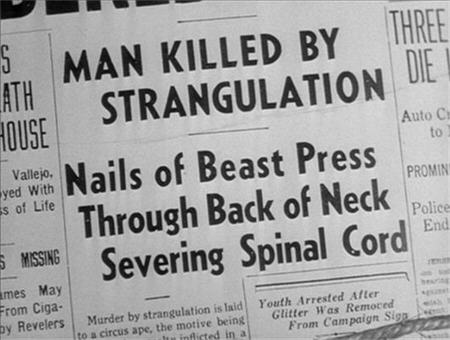
Removing glitter is a criminal offence!?
(The surgical sequence is punctuated by cutaways to Mason “training” a tiger—by putting it in restraints, half-choking it, hitting with a stick, and terrorising it by cracking a whip and firing a gun near it—ugh!! Can we please get back to the unethical experimentation!?)
Anyway, whatever Walters is doing, it causes Cheela to physically transform into something at least resembling a young woman…although at this point, all we see is her hand, projecting from beneath the surgical sheets, changing from that of a gorilla into that of a human female.
It isn’t clear what Miss Strand thought the purpose of this experiment was, but the hand-change tips her over the edge. She announces wildly that Walters can’t go on, that over the years she seen his thinking become warped, that she won’t be complicit in what amounts to murder. Her comments reveal to the viewer that the ultimate goal of Walters’ work is to create a race of supermen…which in conjunction with those racial improvements we were hearing about earlier tends to imply that the good doctor is, well, one of THOSE “Sigmunds”…although oddly enough, the film itself never suggests so even distantly.
Walters listens to Miss Strand’s denunciation of his work with an air of amused contempt, but when she threatens to put a stop to it by calling the police – and chooses, in doing so, to follow the long-standing cinematic tradition of denouncing a madman while alone with him – he observes that while transfusing a female gorilla with human sex hormones is all very well, what would really be interesting would be putting a human cerebrum into her skull, in order to establish “mental stability”; and since he still needs Dorothy’s secretions, obviously he can’t use her cerebrum…

“With my army of hormonally-charged super-bananas, I shall rule the world!”
Some unspecified time later, then, we find Walters unwinding the bandages from what used to be Cheela the gorilla—revealing to us a young woman, apparently human, whom he dubs “Paula Dupree”.
Having made her screen debut uncredited in 1942, Burnu Acquanetta – her name eventually simplified to just “Acquanetta” – made two films for Universal in 1943, in both of them scoring an “—and introducing” credit. Though at this point she was promoted as “the Venezuelan Volcano”, it seems that prior to her film career, Acquanetta had made a practice of “passing” as Arapaho in order to disguise the fact that she was African-American. (Note the implication of a hierarchy of “acceptable” ethnic origins.) Attempts to trace her real background suggest that rather than growing up on an Arapaho reservation in Wyoming, as she tended to tell interviewers, Acquanetta was born Mildred Davenport in a small town in Pennsylvania, where her brother, Horace, studied law and became one of the first African-American judges in his district.
Be all that as it may, Acquanetta was certainly cast in Captive Wild Woman for her “exotic” looks—and, as an actress, handed an impossible job. She is entirely silent as Paula, and forced to try and convey both her, uh, primitive nature and her mysterious power over animals simply through her body language. Her task was not simplified by the fact that, like Milburn Stone, Acquanetta is of course never in shot with any of the animals she is supposed to be “controlling”. However, she certainly looks the part she was asked to play…not least because, in spite of what we must conclude was extensive brain surgery, she still has a full head of hair.
When spelling out to Miss Strand her qualifications as brain-donor, Walters specifically mentioned her “receptive mind” – by which he presumably meant she was suggestible.
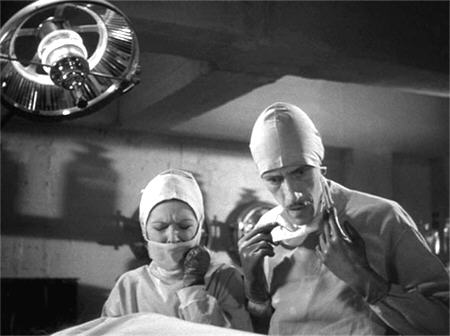
“The malpractice insurance is paid up, right?”
Walters now begins making use of this quality, impressing upon Paula that she must obey him…via a speech that comes alarmingly close to a twisted version of the Vulcan mind-meld:
Dr Walters: “Your mind is my mind. Your every thought is my thought.”
…although granted, the Vulcans don’t usually follow up with, “What I tell you to do, you will do.”
It turns out that Dr Walters is one of those rare movie scientists who actually writes up his experiments – although truly, what he keeps is less a laboratory notebook and more a diary. In it he records the conditions of both Dorothy and Paula, noting that the latter’s “mentality” is improving, whatever that means, and speculating over her reaction to being returned to her old environment (by which, sadly, he means the circus, not Africa), and encountering Fred Mason again.
Now…isn’t this a little odd? And I don’t just mean odd in the sense of pumping a gorilla full of sex hormones and then giving it a brain transplant. I mean, why should Paula retain Cheela’s memories if she has Miss Strand’s brain?—or at least, her “cerebrum”, which contains the temporal lobe, the area of the brain where memories are formed and retained.
In fact, far from “reacting” to Fred Mason, we would expect Paula to have a very different reaction, given that (as was perfectly obvious to the viewer) the reason Miss Strand kept quiet for so long while Dr Walters ran off the rails was that she had a raging crush on her employer – and who can blame her?

Dear diary, today I transplanted Miss Strand’s cerebrum into a gorilla, tee-hee! I hope Beth Colman calls like she promised, she’s dreamy…
And now, depressingly, we return to The Wonderful World Of Tiger Torment, joining Whipple and Mason as the former laments that he has, “20 tigers, 20 lions and no Beatty.” Mason announces that he would like to take a crack at the job, enthusing over his mental image of “working” lions and tigers at the same time. Whipple finally gives him his chance, though Beth is understandably less than thrilled at the prospect. Lengthy scenes of animal abuse follow, capped off by a lengthy and savage fight between a lion and a tiger – gosh, thanks!
In the middle of all this, Walters turns up with Paula, who he passes off as one of his patients. Sure enough, she reacts to her surroundings with a series of worried looks; while the animals in turn react to her presence, becoming agitated. The timing of her arrival is fortunate for Mason, since – YES!! – one of the lions leaps from its metal perch, knocking the pedestal over and knocking out Mason. Unfortunately, instead of immediately finishing the job, the lion turns its attention to a tiger – dammit, lion! – and so Paula has time to dash into the cage, face the lion down, and rescue Mason, as the others look on in astonishment, and Walters smirks in satisfaction.
The single-minded Mason immediately starts contemplating including Paula in his act, though when Whipple protests the very thought of, “A cage of animals and a girl mixed up in it”, Mason counters that he only intends to have her stand outside the cage. (How convenient.) Mason eventually brings Whipple around by threatening to quit, and the next thing we know the papers are spruiking Paula’s inclusion in “the Mason animal act”…though this inclusion consists of nothing more than the girl standing outside the main cage and opening her eyes as wide as she can “controlling” the animals, which you’d think would hardly make for a thrilling spectacle.
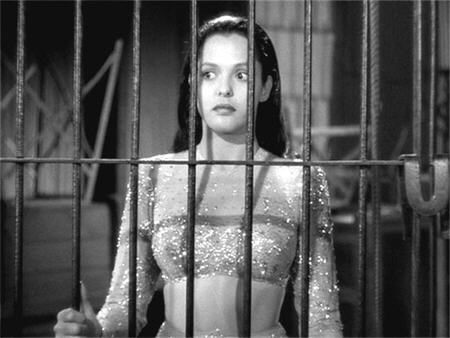
“I remain confident that if I stand here like this long enough, Edward Dmytryk will eventually give me some direction…”
However, the upshot of this is that Paula and Fred spend many hours working together – with Fred’s praise of Paula taking the form of hand-squeezing, an arm about her waist, and the occasional, “Honey.” Hmm. At last we witness the full dress-rehearsal – meaning that Paula is now wearing a skimpy costume – and are given every chance to absorb the fact that the act in truth consists of Paula doing all the work while Mason takes all the credit. Typical.
Anyway, the final rehearsal goes without a hitch, and Mason flies gleefully out of the cage—into the arms of Beth:
Fred Mason: “I wonder if you’ll be so easy to train after we’re married?”
We can only wonder where Beth has been all this time, as it seems that until this moment Paula was unaware of the relationship between her and Mason. Paula storms back to her dressing-room, messing the place up and writhing in silent grief and anger. Then, in the midst of her agony, she feels a strange transformation coming upon her…and as she stares in horror into the mirror, she sees herself beginning to revert…
That night, as Beth sleeps, a strange figure scales the outside wall of her boarding-house and slips through the window into her bedroom. Luckily for Beth, she wakes in time for her terrified screams to bring help—and unluckily for that help, it attracts the intruder’s attention…

“Are you using your cerebrum?”
And then, despite having come to kill Beth, not some random stranger, the intruder leaves without laying a hand on her.
(In absolutely typical B-movie fashion, we never find out who the victim is! Beth’s room-mate? Her neighbour? Her landlady? Your guess is as good as the screenwriters’.)
The doctor summoned to the scene of this violent death points out the “deep, claw-like incisions” that have “cut the spinal cord” and “don’t seem to have been made by human hands”. To the police, Beth insists only that the intruder was, “A weird-looking creature”, but privately she knows very well who it looked like…
Meanwhile, Paula has returned to Crestview, where a furious Walters is getting his Moreau on, ranting about the fact that Paula’s “terrific emotion” has destroyed “the new tissues in your gland growths” (?):
Dr Walters: “I operated on you! Grafted glands from a living woman into your body, watched you transform! Now I have to do it all over again!”
That stubborn beast flesh, huh?
“Everything I planned, completely destroyed because of your madness! Your insane attempt to kill Beth Colman!” he says angrily, terrorising Paula with a vision of trial, conviction and execution, which doesn’t seem very likely; at least, not hers. “I have myself partly to blame,” he concludes.
Oh, not really!?

It’s her hormones.
While I describe Walters as “getting his Moreau on”, Captive Wild Woman remains amusingly skittish about the implications of the relationship between Mason and Paula, and Walters’ reasons for throwing the two of them together. It is only now, as Walters dissects Paula’s behaviour – and with Paula safely reverted to non-human form – that he openly declares her to be motivated by “jungle instinct”, and Beth guilty of “standing between you and a mate”.
Meanwhile, as opening night draws nearer, Mason is getting panicky over Paula’s disappearance. (Because heaven forfend he should have to rely on his own abilities.) He contacts Walters, who tells him that he only knew Paula as a patient, and that he doesn’t know where she’s gone.
As Mason frets, Beth brings herself to tell him what’s been on her mind since the attack – that the intruder killed like Cheela, but looked like Paula… Then, too, what are they to make of Paula’s unnatural control over the animals?
But of course, Mason isn’t listening:
Fred Mason: “Look, honey, you’re letting your imagination run away with you – take it easy!”
Sigh.
Mason is determined that his act will go ahead with or without Paula – and in spite of the imminent violent storm that has Whipple in a stew. Beth is getting ready to attend his performance when her phone rings. It’s Dorothy; a terrified Dorothy, who begs her sister to take her away from Crestview, and not to let Walters perform “another of those operations”. Beth is trying to soothe Dorothy’s fears when Walters intervenes. Dorothy utters one panicked cry before she and her sister are cut off…and from assuming Dorothy is merely worried about her medical treatments, Beth realises that something is really wrong.
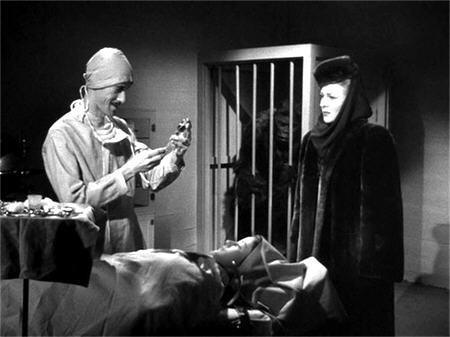
“Isn’t this nice? We really should get together like this more often…”
Beth immediately sets out for Crestview, and forces her way into Walters’ office. Hearing her, he emerges from the laboratory – and suavely invites her to see her sister. Of course, he has another reason for bringing Beth into the operating-theatre…
Inside, we find Dorothy on an operating-table, and a fully gorilla-ised Cheela in her cage. Walters tells Beth she’s about to witness something miraculous: the transformation of an animal into a human being:
Beth: “You’re mad! I won’t let you do it. I’ll go to the police!”
Walters: “Someone else once said the same thing to me…”
And indeed, Walters intends that Beth will follow in Miss Strand’s footsteps, so to speak.
As he begins to prepare for the operation, Cheela begins acting out, rattling her cage and grunting. “She’d love to get her hands on me,” Walters chuckles, so smugly sure of himself that he turns his back…
…granting Beth an opportunity to take him at his word: she steps back, and opens Cheela’s cage…
And really, we have to stop and give Captive Wild Woman some credit here, in that it is Beth who joins all the dots of this bizarre story, and Beth too who disposes of the villain – with help from Cheela, of course – rescuing both herself and her sister in the process, without even token intervention from the male sex.
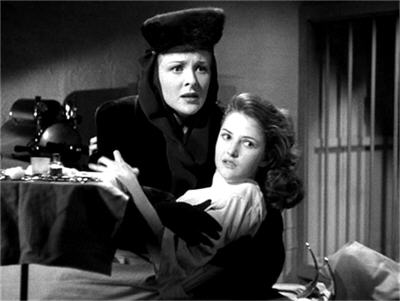

“Well, ladies, I’d love to stop and kill you, but I have to go rescue that useless Fred Mason.”
Even so—there is one uncertain moment when, having disposed of Walters, Cheela turns back and briefly contemplates the frightened Colman sisters…but then she turns away again, with something more urgent than even Beth’s demise on her mind: the fact that Fred Mason is trying to do his animal act without her…
So he is…and what’s more, the storm that Whipple predicted is just breaking in all its violence. In short order, the circus tent begins to collapse, the audience stampedes, and the animals panic and run.
Mason takes care of the latter, at least, rounding up the big cats and driving them back into their cages without a single spectator being so much as nipped – all but Nero. Over Whipple’s protests, Mason goes back into the main cage, trying to recapture Nero, too, but the lion has other ideas—finally, finally, leaping upon Mason and starting to maul him…
…which is of course Cheela’s cue to appear. Dammit, Cheela!
But yes, the gorilla rushes into the cage and drives Nero away from Mason and into its cage. She then picks up the helpless Mason and carries him to safety…
…which, I simply must point out, gives us a direct gender inversion of the advertising art for Captive Wild Woman, almost all of which gives us the traditional scene of a woman – unconscious in some images, terrified in others – in the arms of a (putatively) male gorilla! (Of course, the same artwork also gives us a frightened Beth cowering behind Mason, sigh.)
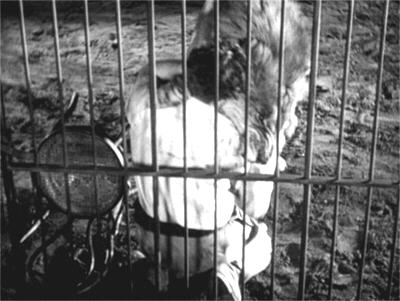
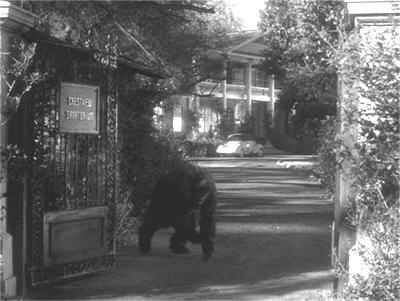
Sadly, the cavalry arrived in time.
So Cheela, like Beth, evinces a distinctly unfeminine ability not just to take care of herself, but to take care of her loved one, too; but unlike Beth, Cheela is immediately punished for it. A security guard, rushing to the scene, misinterprets Cheela’s rescue of Mason and promptly shoots her in the back – fatally. Mason’s injuries, meanwhile, turn out to be disappointingly superficial. Dammit, Nero!
So it’s an unhappy ending all around; and to underscore the fact, Captive Wild Woman closes with a shot of Crestview Sanatorium, as a voiceover guy intones Dr Walters epitaph, paraphrasing Miss Strand:
“And so behind those gates is buried the legend of a mortal who went beyond the realm of human powers and tampered with things no man should ever touch…”
Want a second opinion of Captive Wild Woman? Visit 1000 Misspent Hours And Counting.
Click here for some Immortal Dialogue.
More on Captive Wild Woman at Spinning Newspaper Injures Printer.
******************************************************************
 This review was part of the B’Masters’ tribute to John Carradine.
This review was part of the B’Masters’ tribute to John Carradine.

Pingback: lmmortal Dialogue: Films A – D | and you call yourself a scientist!?
Pingback: Association of ideas « The B-Masters Cabal
Pingback: Spinning Newspaper Injures Printer | and you call yourself a scientist!?
Just saw this one, and between the immense amount of the runtime using stock footage and the absolute insanity of the mad science (which feels absurdly transgressive for a Code era flick) I just had my jaw open the whole movie!
LikeLike
The censors often didn’t look at B-films as closely as A-films, so you do find find eyebrow-raising stuff…
LikeLike
John Carradine is really what sells this movie. It’s hard to get through a movie that is essentially one half stock footage – and extremely upsetting stock footage at that. You have to decide how much to hold that against the flick. But Carradine treats his role seriously and it goes a big way to making it scary. Karloff’s mad scientists were always noble but deluded, and George Zucco’s were always a bit too campy to really find threatening. Carradine really fills the shoes left by Lionel Atwill after he self-destructed his career.
LikeLike
I don’t usually recommend this sort of tampering but I think a version of Captive Wild Woman that is just the Carradine plot would be delightful!
Yes, fair comment on the Madness Hierarchy…
LikeLike
Just what office was that candidate running for, that glitter was needed on the campaign sign?
I read the Immortal dialogue. The doctor changed the breed and sex of animals? He was extremely gifted.
I’ve read several mystery novels from the 20’s to the 30’s, and at that time glands were just beginning to be studied. The possible implications in the minds of laypeople were astronomical. One novel (The Documents in the Case, I highly recommend it) quotes a scientist about the tendency of the press to blow ideas out of proportion.
“If anybody says there are vitamins in tomatoes, they rush out with a tomato theory. If somebody says that gamma rays are found to have an action on cancer cells in mice, they proclaim gamma rays as a cure-all for everything from old age to a cold in the head.”
So there were no speculations about glands that would be considered too outlandish.
LikeLike
Or maybe we’re in San Francisco? 🙂
And it isn’t just the speculation: what was actually done as “a treatment” for whatever – usually ageing, of course – was pretty damn terrifying!
(Black Oxen, which I reviewed in Et Al., is in this territory too, of course.)
LikeLike
One pathological version of this is John R. Brinkley (the “goat glands” guy – not technically a doctor, though he often said he was). It’s not so much what he did, as that it was widely considered plausible at the time; a successful medical scam is all about catching the mood of the day.
LikeLike
The circus failed to ask of Mason that one crucial question for any prospective lion tamer: “Does he have a hat?”
LikeLike